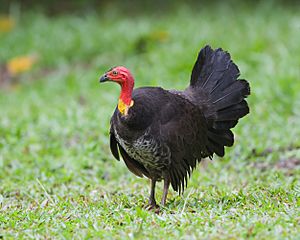Fowl facts for kids
Quick facts for kids Fowl |
|
|---|---|
 |
|
| Australian brushturkey (Alectura lathami) | |
| Scientific classification |
|
| Kingdom: | Animalia |
| Phylum: | Chordata |
| Class: | Aves |
| Infraclass: | Neognathae |
| Superorder: | Galloanserae Sclater, 1880 |
| Subgroups | |
|
|
The fowl are a special group of birds. They belong to one of two main bird groups: the gamefowl or landfowl (Galliformes) and the waterfowl (Anseriformes). Birds in these groups are often hunted or raised on farms for food. Because of this, the word 'fowl' is often used for birds we eat.
Scientists have studied these two groups of birds very closely. They looked at their body structures and their molecules, like DNA. These studies show that gamefowl and waterfowl are very close relatives. Together, they form a larger group called the Galloanserae. This name comes from "Gallus" (like chickens) and "Anser" (like geese).
Contents
What are Galloanserae?
The Galloanserae are a large group of birds that includes many familiar types. This group contains all the landfowl, such as chickens, turkeys, pheasants, and quail. It also includes all the waterfowl, like ducks, geese, and swans. These birds are found all over the world. Many of them are very important to humans for food.
Landfowl (Galliformes)
Landfowl are often called game birds or poultry. They usually have strong legs and feet for walking and scratching on the ground. Many landfowl can fly, but often only for short distances. They prefer to live in forests, grasslands, or near farms.
Some well-known landfowl include:
- Chickens: These are the most common type of poultry raised for meat and eggs.
- Turkeys: Large birds often raised for meat, especially around holidays.
- Quail: Smaller birds, often hunted for sport or raised for food.
- Pheasants: Colorful birds, popular for hunting.
Waterfowl (Anseriformes)
Waterfowl are birds that are well-adapted to living in or near water. They often have webbed feet, which help them swim. Their feathers are usually waterproof, keeping them dry in the water. Waterfowl are found in lakes, rivers, ponds, and coastal areas.
Some common waterfowl include:
- Ducks: Many different types of ducks live in various watery habitats.
- Geese: Larger than ducks, geese are known for their strong calls and V-shaped flight patterns.
- Swans: The largest waterfowl, known for their long, graceful necks.
How Scientists Study Bird Relationships
Scientists use many tools to understand how different animals are related. For the Galloanserae, they have looked at several things:
- Body Structure: They compare the bones, muscles, and other parts of different birds. Similarities in these structures can show a close relationship.
- DNA: By studying the DNA sequence (the genetic code) of birds, scientists can see how similar their genes are. Birds with very similar DNA are usually closely related.
- Retrotransposons: These are special bits of DNA that can move around in an animal's genes. If two species share the same retrotransposons in the same place, it's strong proof they came from a common ancestor.
All these different types of evidence show that landfowl and waterfowl are indeed close relatives. They all share a common ancestor, meaning they are part of the same big family group, the Galloanserae.
See also
 In Spanish: Galloanserae para niños
In Spanish: Galloanserae para niños

